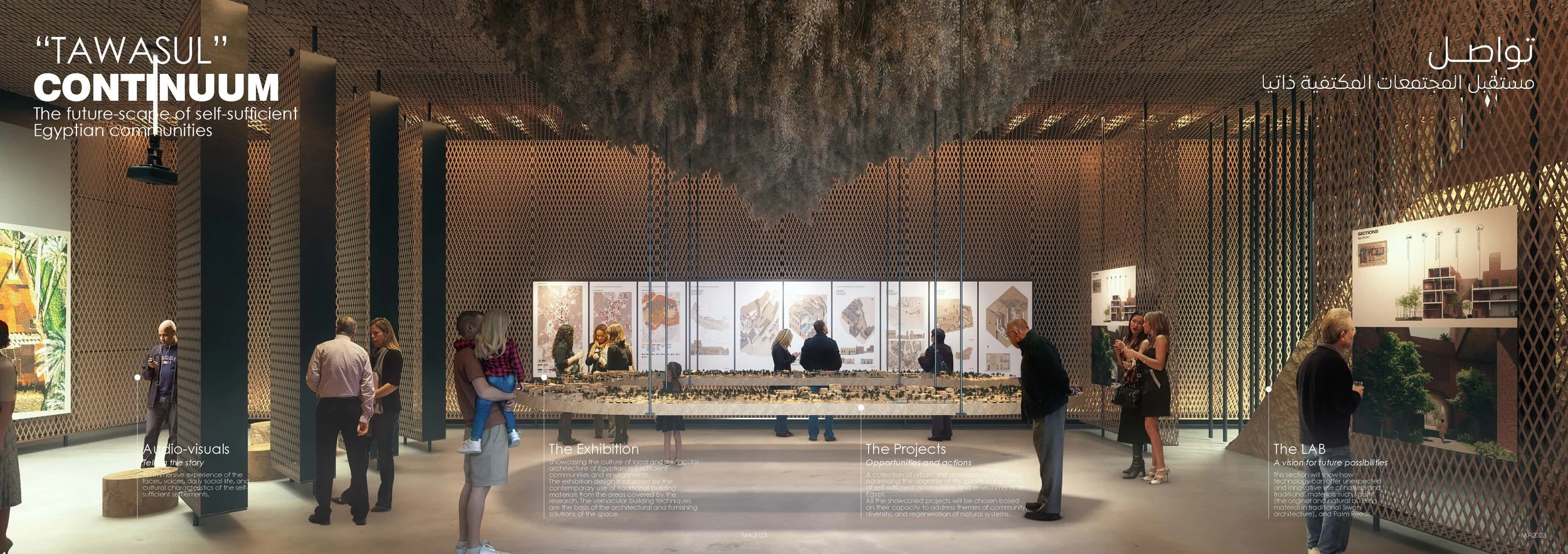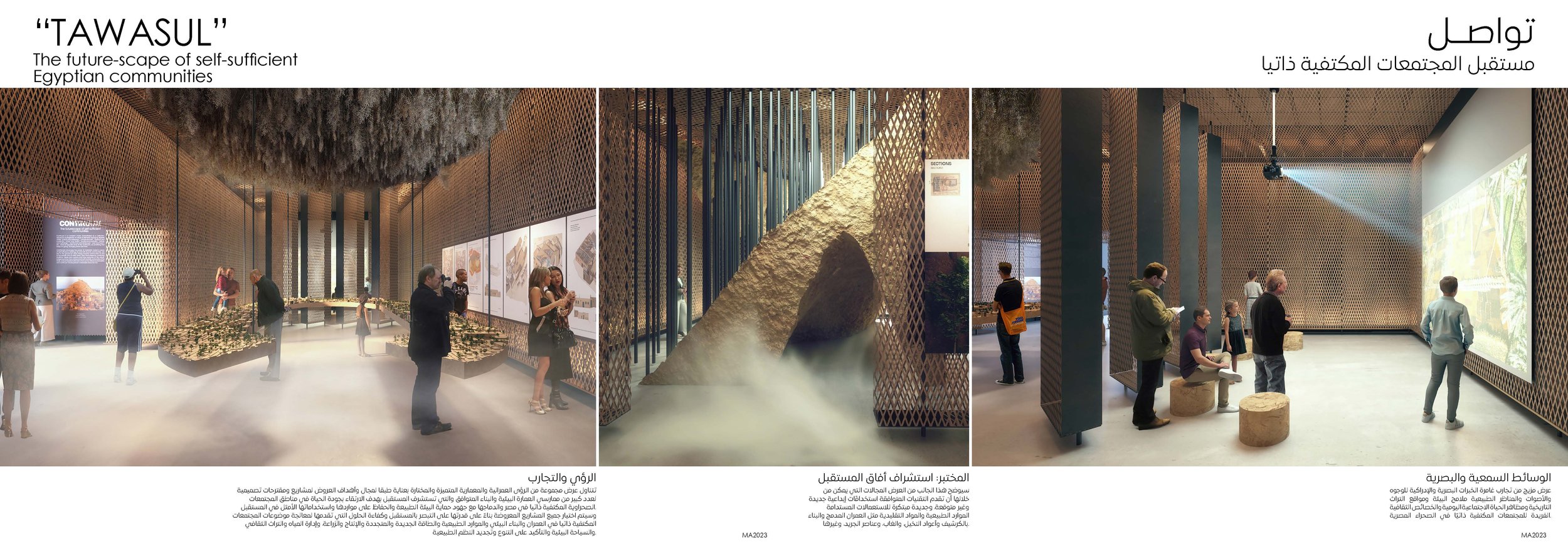“TAWASUL” _ continuum تواصــل / “The future-scape of self-sufficient Egyptian communities”
DESIGN TEAM : Galal Abada, Mouaz Abouzaid, Islam El Mashtooly, Cristiano Luchetti
Honorable Mention / The Architectural Competition for Presenting Egypt in the 18th Architecture Venice Biennale organized by The National Organization for Urban Harmony, Ministry of Culture, Egypt.
The contemporary age is the bearer of countless problems that affect our current life from many points of view. It is not just the present time that is complex. At the horizon, humanity can perceive future challenges that are awe-inspiring because of their possible planetary scope. Their level of complexity and danger seems to go hand in hand with the level of technological dominance that strongly characterizes the spirit of the times in which we live. In the modern age, technical and economic progress has too often been perceived as the goal of human activity. Unfortunately, it is undeniable that the consequences and un-sustainability of such are becoming increasingly evident and threatening to the next generations and the planet's future. The first industrial revolution began the modern globalization process, which allowed the exchange of knowledge at levels never experienced before. However, the exponential increase of communication between peoples has not only been the bearer of positive factors and improved living conditions. As the ease and speed of exchanges and interactions between populations grew, the fears of losing local cultural and identity values have also evolved.
Like many other nations similarly positioned globally, Egypt is witnessing a growing economic expansion that does not always reach its entire society. As in many other places in the world, there are substantial differences in living conditions between the various sectors of the population. Some people managed to engage and exploit the opportunities of economic globalization. In many cases, this part of society has reached levels of well-being that can be compared with those of the richest Western countries. On the other hand, many Egyptians are still far from this reality and find it difficult to access similar levels of economic progress and general improvement in living conditions. Our idea for the exhibition that the Egyptian pavilion will propose at the Venice Architecture Biennale in 2023 stems from this context.
The difference in living conditions between urban and rural areas, especially in the desert settlements, is still a predominant phenomenon in Egypt. The massive transfer from the countryside of substantial portions of the population to the most significant urban centers initially caused a fast pace expansion that was impossible to regulate, given its size and speed. The "historic city," increasingly besieged by the informal one, failed to establish and implement solutions that could determine proper strategies for sustainable growth. Faced with the progressive worsening of urban conditions, the wealthier classes have preferred to move to and settle in new suburban cities to the existing ones. These cities of new foundation can now guarantee better living conditions, although raising many questions about their impact on Egyptian society. The picture changes if our attention goes beyond the Urbi (the city) and turns to the Orbi, the rest of the Egyptian territory not included in the increasingly less definable urban morphologies.
In the "rural-side," the absence of modernity is immediately recognizable. The Egyptian metropolitan characteristics, so like many other global realities, are not present. The landscape rarely offers signs of modernity on the journey through these territories, especially the more remote ones. Much more frequently, it still welcomes and incorporates the memory of traditional vernacular building and farming knowledge. Such a context is comparable to many other places. However, we are interested in bringing to light specific Egyptian phenomena that can be disseminated, through the Venice Biennale, to the rest of the world.
The holistic urban and environmental analysis of some "self-sufficient" settlements and oases will constitute the main subject of our research. Our investigation identifies the possibility of re-learning from the places and practices of a world that, over time, has developed its proper contextual strategies. Without the sudden leaps forward in modernity, which often causes the loss of historical know-how, the architecture of these communities has long since established co-existing relationships with its original environment.
The functional and identity "self-sufficiency" can be read dually in the Egyptian rural settlements. On the one hand, they establish an adequate distance from the homogenizing logic of global culture. However, at the same time, they could promote their existence as an alternative condition of cultural retention and economic resilience. In this context, the concept of self-sufficiency can be characterized as a collection, sequence, or progression of values (elements). "Scarcity and adequacy," "natural and built," "continuity and change," "virtual" and "reality," "locality and universality," "folklore and mythology," "architecture and landscape," "past and future," etc., stand at opposite ends of the continuum, as something that keeps on going, changing slowly over time. With our research, we do not want to promulgate a nostalgic-reactionary approach. We intend to study examples of desert and rural settlements (laboratories) in Egypt, which could establish alternative models of sustainable coexistence with larger global issues, identifying, at the same time, design proposals that could accompany them toward a sustainable future.
Our theme, "CONTINUUM," denotes "a whole that is made up of many parts" and describes a range that is always present; a continuous whole or extent or succession in which no portion is distinct or distinguishable from adjacent parts. It is the exploration of the role of the architecture of self-sufficient communities. The permanence and durability of a settlement in a context of low technological changes should merge respect for history, tradition, customs, and rules in which architecture can become a source of continued and lasting well-being beyond the realm of architecture as a discipline.
The pavilion will showcase the power of materiality rooted in a place of Self-Sufficiency. Indeed, Scarcity communities are tied to the ground. The combination of traditions and customs characterizes their identity. They gather resources from nature. They hold indigenous know-how, culture, local craft and skills, and society, yet they are transformational in what can be offered. Applied sustainability and "CONTINUUM" should prevent undesirable resource loss. Our proposal for the Egyptian pavilion at the 2023 Architecture Venice Biennale will showcase highly performative and expressive architecture. We will incorporate local, national, regional, and global dimensions in a balance of low-tech grassroots heritage, translating into a universal, inspiring language that symbolizes the architecture of scarcity. It is a sensitive, bottom-up approach embracing community values and traditions and adaptive solutions. Such local and global perspective goes well beyond aesthetics, integrating past experiences and current practices with future envisions.


